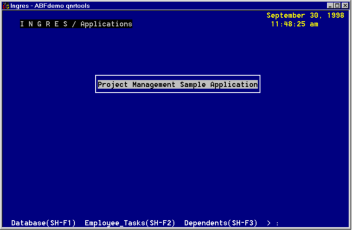User-specified Frames
A user-specified frame is defined by the application developer. After you create the user-specified frame in ABF, there are three steps in defining the frame:
• Specify the name and operations to be performed for each item on the menu of that frame with 4GL.
• Design the form for the frame with the FormEdit operation. (See Forms below.)
• Create a 4GL specification defining each menu operation along with statements that determine what happens when the user chooses each operation.
These steps can be performed in any order.
When running, the frame displays the form and menu in a window. When the user chooses a menu operation, the 4GL code for that operation is executed, causing the application to perform the associated actions, including:
• Run other frames and procedures, and start up Ingres tools.
• Run external applications or system programs, display your own help files, and perform specific data manipulations.
The following figure shows the main menu frame of the sample ABF application described in The ABF Demo Program. This is a user-specified frame that consists of a menu of operations and a form containing several lines of trim.

For more information on user-specified frames, see Building Applications, and ABF Development Example.
Last modified date: 04/03/2024